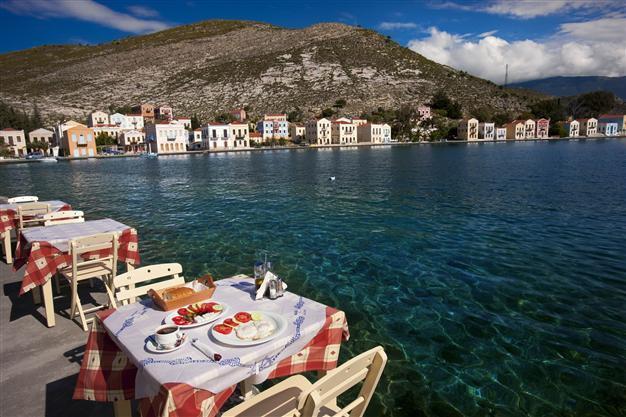BLOG: Destination: Kastellorizo, a Greek treasure hidden in the heart of Turkey
Selina Bieber
 It was a cool February, flights were scarce in the off season and I flew into Dalaman with a colleague at some ungodly hour. We began a leisurely drive along the coast, dozing off to sleep before stopping off at Göcek for breakfast. There was almost no one in sight, the cafés were empty, some still closed waiting for the first round of visitors to start the season off, but the warmth of the sunlight shining through was a welcome change from the grey skies we’d left behind in Istanbul. We continued along our journey before commencing my first encounter with the quaint, picturesque town of Kaş and my later romantic trip to the quiet island of Kastellorizo.
It was a cool February, flights were scarce in the off season and I flew into Dalaman with a colleague at some ungodly hour. We began a leisurely drive along the coast, dozing off to sleep before stopping off at Göcek for breakfast. There was almost no one in sight, the cafés were empty, some still closed waiting for the first round of visitors to start the season off, but the warmth of the sunlight shining through was a welcome change from the grey skies we’d left behind in Istanbul. We continued along our journey before commencing my first encounter with the quaint, picturesque town of Kaş and my later romantic trip to the quiet island of Kastellorizo.Entering the town brought a breath of fresh air, a desire to explore the warmth of the oncoming summer as people awaken from their winter slumber, ready to embrace new discoveries and new routes across the expanding seas. Unknown to many, a natural blend of two epic historical cultures lies almost untouched on this shoreline, across the water from Kaş lies a Mediterranean treasure waiting eagerly to tell new visitors its tales of history and enchant them with its charm: the tiny Greek island known as Kastellorizo. And I was more than curious to explore.
Known for centuries as two opposing societies, today, this tiny island leaves people from all walks of life marvelling at its harmonious blend of Greek and Turkish history in an idyllic setting, while simultaneously creating a unique intermingling of these two great peoples to offer an escape from the bustle of the city and everyday life.
I seized my opportunity to experience Kastellorizo in the warmer month of May. From Kaş, boats run daily to the island pending a Schengen Visa for Turkish passengers as the island does, after all, belong to Greece. Approaching the island by sea, you are immediately drawn in by the tranquil, yet rich blue waters surrounding the island and further enveloped by the affectionate row of quaint Greek-style houses greeting you as you walk ashore. The pale white and pastel shades of yellow, blue and rusty oranges characterizing the local homes and waterfront cafés are accentuated by the timber doors and window shutters, renovated as they slowly aged with time. The colors of these two and even three storey houses contrast with the blue of the sea, against a backdrop of mountainous green terrain.
Less than 1500m from Kaş and 115km from Rhodes, Meis, as the island is known in Turkish, is the second closest Greek island to Turkey after Samos on the southeastern Turkish coast. The proximity between the two countries means a continued blend of the two societies, sharing produce, tourism and entertainment, all of which make the mass of water separating the two countries almost irrelevant.
Each year, the month of June is the epitome of this melting pot with the International Lycian Culture and Arts Festival bringing together the two local mayors and their people. Concerts, traditional dances and foods are topped off by a swimming and canoe race between Kaş and Kastellorizo; festivities are celebrated by locals and tourists alike.
Dating back to as far back as the Neolithic times, the island today is nothing of a reflection of the importance it held in ancient ages. Known as Megisti by its first settlers, the Megisteas, the island is home to an array of archaeological artifacts telling the tales of history to the modern world.
The years that followed the island’s birth saw the island go between East and West, the Turks and Greeks, while it rose to prominence as a center point of shipping, trade and literature; acting as a meeting point for Europe and the Middle East. The Italian occupation, not surprisingly documented passionately in the 1991 Oscar winning film “Mediterraneao,” meant the decline of the island with its population dropping from as much as 14,000 inhabitants to the mere population of 406 that we witness today, ending the era of shipping and literary prosperity. However, the film does not fail to evoke the warmth of the island and its remaining population. The island continues to celebrate its independence from this era on Sept. 13 each year with festivities and visits from local prominent figures, as well as Greek politicians travelling in from the mainland.
The undisturbed silence to be heard between the walls of the brightly painted houses and stoned paved streets meandering along the island tell the tales of this history left far behind, creating an indefinable energy. The tiny port of the island surrounds you with an array of almost toy-like colorful boats floating lightly on the water’s surface, making you instantly feel as you have entered a scene of a rather romantic movie.
Adorned with cafés and restaurants, visitors are warmly welcomed by locals and smells of fresh coffee and seafood along the promenade. With fresh produce being brought in from Kaş and caught from the deepest depths of the Mediterranean, meals in Kastellorizo are a definite highlight. Sitting under the cool shade of café umbrellas to escape the day’s heat lapping up the general seaside atmosphere; your meal begins. Imagine hot, fresh bread and a selection of Greek “mezes” from the yogurt-based tzatziki (cacık), to a delectable mix of eggplant and red peppers, complimented by my favorite the fried cheese saganaki. The traditional Greek salad is accentuated by the smoothness of feta cheese and olive oil drizzled over it. For the main course, meat lovers can enjoy a traditional plate of lamb meatballs or skewers with a cool refreshing Greek beer, however, seafood is highly recommended. The flavor of a fresh catch of fish or if lucky, lobster, enjoyed in one of the cafés along the promenade to the soft sound of boats moving on the water and laughter of other visitors delighting in similar scenes is something not to be missed. The meal is, of course, not complete without a “Greek” (or maybe Turkish!) coffee to top off your culinary experience.
A meal, however, is not earned without first exploring the island. And despite the island being small, it is in no way short of sights to see. Characterized by its tranquility and rustic authenticity, visitors set off mainly on foot – especially considering there is only one taxi catering for the entire island.
The castle overlooking the island is the first point of attraction as you walk eastwards up from the promenade area. The castle was built on the ruins of an ancient 14th century castle by the Knights of Saint John. The walk up to the castle, named Castello Rosso, referring to the red rocks it was built upon, takes you along a scenic tour of the waterside. The path begins smoothly as you walk along the very edge of the land until the promenade is no longer visible and you find yourself overlooking the port of the island. A paved stairway leads you toward the castle, growing steeper as you move further up to its base. At its foot, you are presented with a breath taking view of the port and the glistening Kaş coastline further off in the distance. Within the castle are two votive inscriptions which date back to the 2nd Century BC, a message left from civilizations once roaming the island. Next to the castle lie the ruins of an old Turkish bath and a restored watermill which you pass as you make your way back down the streets into the center of the town.
The archaeological museum also found on the eastern side of the island is full of artifacts from Kastellorizo’s history, from coins and vases to an old diving suit; yet, it is the museum’s own authenticity and setting which captures one’s attention. A stone built tiny building, in its center lays a courtyard separating the entrance of the museum and its upper sections, visitors walk through the quadrangle slowly taking in the various items on display while never once losing contact with the magical air of the island.
The most talked about wonder of the island is perhaps the secluded Blue Cave. Kastellorizo is home to many caves; however, hidden in the southeastern side of the island and only accessible by boat, this untouched cave is beyond magnificent. Stalactites and stalagmites look down as you move through the water. At 35-40m high and 40m wide, the cave is renowned as one of the largest grottos in Europe and is an extremely popular spot for scuba divers and snorkelers.
While I only visited the island for a day, I would take any opportunity to revisit and disconnect on the island for a few hours – with a group of friends you can count on a truly enjoyable afternoon.
















